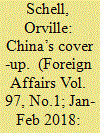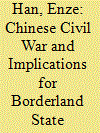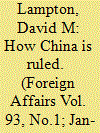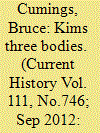| Srl | Item |
| 1 |
ID:
157414


|
|
|
|
|
| Summary/Abstract |
The Chinese Communist leader Mao Zedong’s “permanent revolution” destroyed tens of millions of lives. From the communist victory in 1949 in the Chinese Civil War, through the upheaval, famine, and bloodletting of the Great Leap Forward and the Cultural Revolution, until Mao’s death in 1976, the Chinese Communist Party (CCP) set segments of Chinese society against one another in successive spasms of violent class warfare. As wave after wave of savagery swept China, millions were killed and millions more sent off to “reform through labor” and ruination.
|
|
|
|
|
|
|
|
|
|
|
|
|
|
|
|
| 2 |
ID:
173464


|
|
|
|
|
| Summary/Abstract |
Few studies on the legacies of the Chinese Civil War have examined its effects on state consolidation in the borderland area between China and mainland South-East Asia. This paper empirically examines the impact of the intrusion of the defeated Kuomingtang (KMT) into the borderland area between China, Burma and Thailand. In the People's Republic of China (PRC), the presence of the US-supported KMT across its Yunnan border increased the new communist government's threat perceptions. In response, Beijing used a carrot-and-stick approach towards consolidating its control by co-opting local elites while ruthlessly eliminating any opposition deemed to be in collusion with the KMT. In the case of Burma, the KMT presence posed a significant challenge to Burmese national territorial integrity and effectively led to the fragmentation of the Burmese Shan State. Finally, in Thailand, Bangkok collaborated with the Americans in support of the KMT to solidify its alliance relations. Later, Thailand used the KMT as a buffer force for its own border defence purposes against a perceived communist infiltration from the north. This paper contextualizes the spill-over effects of the Chinese Civil War in terms of the literature on how external threats can potentially facilitate state consolidation.
|
|
|
|
|
|
|
|
|
|
|
|
|
|
|
|
| 3 |
ID:
126273


|
|
|
|
|
| Publication |
2014.
|
| Summary/Abstract |
China had three revolutions in the twentieth century. The first was the 1911 collapse of the Qing dynasty, and with it, the country's traditional system of governance. After a protracted period of strife came the second revolution, in 1949, when Mao Zedong and his Communist Party won the Chinese Civil War and inaugurated the People's Republic of China; Mao's violent and erratic exercise of power ended only with his death, in 1976.
|
|
|
|
|
|
|
|
|
|
|
|
|
|
|
|
| 4 |
ID:
115613


|
|
|
|
|
| Publication |
2012.
|
| Summary/Abstract |
The North's philosophy of rule bears close resemblance to what Koreans traditionally said about their kings-or what Hegel said about the German monarch. .
|
|
|
|
|
|
|
|
|
|
|
|
|
|
|
|